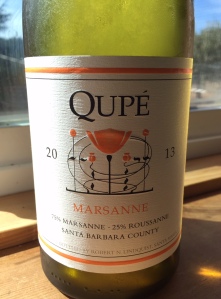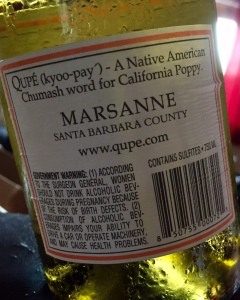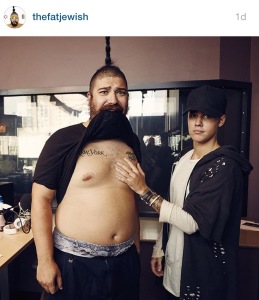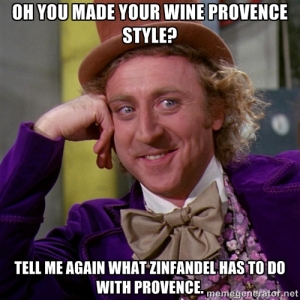It’s ANOTHER “Summer’s Swan Song” post on this balmy Friday! We had a bit of an Indian Summer here in Oregon and it was actually really lovely. Well, maybe not so lovely for the fruit-pickers that are currently working their @ss’s off all over the Valley, but for me? Divine. It made me want to eat all the Summer produce one last time. Tomatoes, watermelon, squash- all of it! So I’m somewhat glad I saved this bottle of Marsanne from Qupé until now. It’s perfect for a Summer Friday afternoon.
Founder and winemaker Bob Lindquist is an original “Rhone Ranger”; he started Qupé in 1982 making Syrah, Chardonnay and dry Rosé in California’s Central Coast. He subsequently teamed up with Au Bon Climat’s Jim Clenenden and the two built a shared facility in 1989. The rest is, as they say, history. Both Au Bon Climat and Qupé have great reputations, and I’m currently being reminded of how badly I need to get to this part of California. I’ll go ahead and add it to my list… which is pretty long. Le sigh.
This wine is made from 75% Marsanne and 25% Roussanne. These two French varieties are bros from way back. Most commonly found in the Northern Rhone, they play off each other beautifully; Marsanne produces wines of great color and depth and are intensely perfumed. Roussanne is a bit stingier, more of a bastard to grow, and usually packs a solid punch of acid, making them great agers. Both these fellas enjoy the Coastal California vibe, basking in the afternoon ocean breezes and morning fog, which helps them maintain their acidity.
Both grapes for this wine are whole cluster pressed. The Marsanne, which comes from roughly 28-year old vines on the Ibarra-Young Vineyard, is chilled in tank for 48 hours before it goes to neutral French oak barrels. The Roussane, interestingly, heads straight to barrel with the lees after an evening chilling. (Literally). Bob prefers the use of once filled Francois Freres barrels previously used for Chardonnay with the Roussanne. I love these little facts. The Roussanne comes from the Bien Nacido Vineyard, one of the oldest in the area for all grapes Rhone.
Now! We gotta talk about what this wine tastes like before I get too much wordier. Its a dark golden strawish color and the nose is a nice combination of slightly tropical with ripe stone fruit. Nectarine, apricot, a touch of pineapple. Once it warms up a bit, you can detect its oak content a bit- hints of baking spice and creamy lemon. You might think it was a flab-fest, but the finish really clenches with pleasant acid and even a drying sensation which leads me to think this wine will age nicely. There’s something that reminds me of menthol lingering in there as well. The texture is viscous and slightly oily, but in a luscious way. Oily is a strange word to use to describe wine, and its connotation would seem negative, but its not intended as such. Its one of those descriptors that makes perfect sense once you identify it.
This is the first California wine I’ve written about in Lord only knows how long! Its been fun. I sometimes forget California exists. Not really. But almost. Hope you enjoyed this little trip to Cali and are as ready for Fall as the rest of America seems to be.
This wine was received as a sample. Its suggested retail cost is $20.





